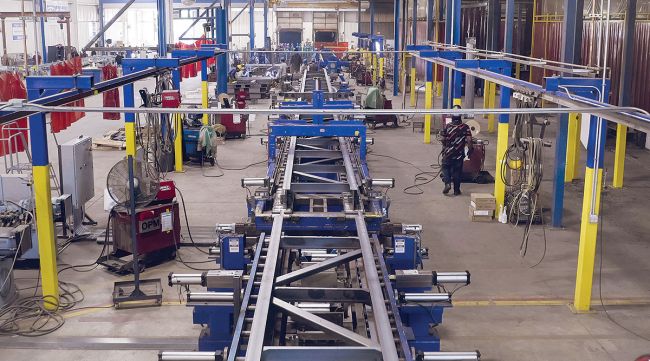Production of trailers in the United States is set to decline for five consecutive quarters before increasing in the final three months of 2024, according to FTR Transportation Intelligence Chairman Eric Starks.
Trailer output in the second quarter of 2023 was 85,000 units, while in the third quarter it is expected to total 82,000 units, and the fourth quarter is forecast to see 74,000 units built, Starks told the FTR Transportation Conference 2023 on Sept. 11 in Indianapolis. Still, that is a decent outlook, he said.
In the first quarter of 2024, FTR — a freight and commercial vehicle equipment forecasting firm — expects output to total 63,000 units followed by 60,000 units in Q2 and 58,000 units in Q3, he said.
Annual production in 2024 is expected to total 243,000 units, compared with 324,000 units in 2023, according to a presentation by Starks.

Starks
FTR expects production to total 275,000 units in 2025, 290,000 units in 2026 and 302,000 units in 2027.
Preliminary data on U.S. trailer orders showed a 41.1% year-over-year decrease to 10,000 from 16,997 in July, ACT Research reported. Each of the first seven months of 2023 saw a year-over-year slide since December 2022 closed out last year at the second-highest level on record.
Despite the downturn in orders, demand has been better than expected in the weak freight environment, Starks told the conference, adding that the recent downturn has been unsurprising.
If one looks at the 12-month moving average for orders, which Starks described as the best way to understand the trailer market, demand has started to ease. Demand for trailers in the U.S. is not expected to grow until 2024, Starks said.

What is supporting the market at the moment to an extent is the post-pandemic backlog, which is at about 150,000 units, Starks said.
Normally, there’s a four- to six-month backlog, and currently, it is 5.8 months on a marketwide basis, Starks said, adding that since the start of 2023, the backlog has been trending lower. At the start of 2023, the backlog was nine months.
The backlog is 6.7 months in the dry van segment, 7.8 months in refrigerated trailers and 6.9 months in dry tanks; however, it is 3.2 months for flatbed trailers and 1.8 months for dump trailers. The latter two segments are likely to see a pull back in production, he added.
Starks said the outlook for dry van trailers is going to be relatively flat until 2025. In the reefer segment, there is an upward trend line, but there will not be as big a jump as some expect, he said. Reefer trailer demand has held above its traditional floor.
The flatbed segment is unlikely to see a slump, although it has been struggling recently. “The flatbed market is seeing some weird behavior, but this was not unexpected,” he said, citing a weaker-than-usual lumber market amongst other factors.

Kenney
Sean Kenney, CEO of trailer manufacturer Hyundai Translead, told the conference the intermodal chassis market is also experiencing a tough time and will do so for a number of years.
Not unlike the rest of the trailer market, said Kenney, demand was extremely hot during the pandemic, but the market deteriorated quickly.
Hyundai Translead sought to take advantage of the explosion in demand during the pandemic, Kenney said, with the company’s annual chassis production increased to around 18,000 from around 2,000 in 2019.
That demand and the opportunities it offered attracted a number of new players to the intermodal chassis sector, he said, adding that those companies now had choices to make with the sector in a time of transition.
In July, Kenney said he expected the segment to have substantial overcapacity in 2024.






